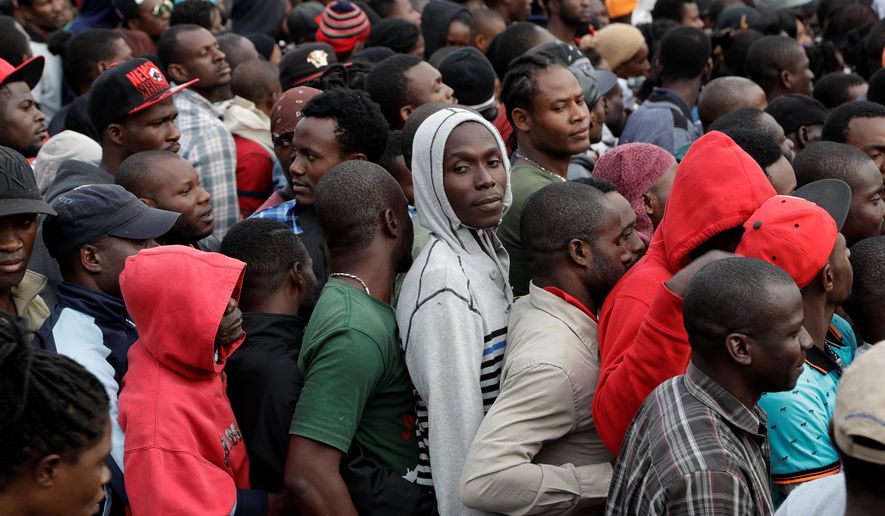Sometime around November, word began to trickle back down the spine of Latin America: The U.S. was getting stricter about letting in Haitians at the border.
Not only had the Obama administration begun deporting Haitians after a six-year humanitarian pause, but President Trump also had just been elected, presaging an even tougher policy.
Many of those en route, such as the hundreds staged at migrant camps in Costa Rica and Nicaragua, figured they had gone that far and had little to lose by trying to finish the journey north.
But for the tens of thousands of Haitians in Brazil, Chile and elsewhere in South America who had been planning to journey north, the news was devastating. In a matter of weeks, the northward stream of people dried up.
It is one of the biggest among a plethora of success stories from the southwestern border, where illegal immigration appears to have nearly dried up in the two months since Mr. Trump took office.
Six months ago, U.S. Customs and Border Protection officers manning the ports of entry were encountering more than 100 Haitians a day. By March, only weeks into Mr. Trump’s tenure, that had dropped to just 100 for the entire month — down a stunning 97 percent.
Rep. Duncan Hunter, a California Republican who was one of the first to expose the surge of Haitians last year and has tracked the issue since, said all it took was a commitment of enforcement to stem the flow.
“The fact that these numbers are not just down, but so significantly reduced, is a direct credit to the Trump administration,” said Joe Kasper, Mr. Hunter’s chief of staff. “It shows what a message of enforcement first signals to the rest of the world and the extent to which the Obama administration’s policies were a problem.”
“We did everything we could to warn the Obama administration about the seriousness of the problem it created and a solution that centered on strong leadership and good decision-making. They were willfully deaf to it all,” Mr. Kasper said. “Now we’re seeing a change in approach and results, all of it without passing a single piece of legislation or providing new authorities.”
The changes go well beyond Haitians.
The number of “inadmissible” migrants showing up at U.S. ports of entry and demanding to be let in has dropped from more than 20,000 in October to about 4,400 in March, a cut of nearly 80 percent. And the number of illegal immigrants nabbed while trying to sneak into the U.S. between the ports is down from more than 46,000 in October to a little more than 12,000 last month.
The Haitian Embassy in Washington has been silent on the issue dating back to last year, despite repeated requests from The Washington Times.
U.S. immigration officials also didn’t offer an explanation for the dip, and the State Department said it didn’t want to speculate about the reasons.
But officials from U.S. Customs and Border Protection and the State Department did point to officials’ decision last year to begin ramping up deportations as a signal to would-be crossers.
Most deportations from the U.S. to Haiti had been suspended since soon after the January 2010 earthquake that devastated the island nation, shattering the infrastructure of the poverty-stricken country.
That earthquake also sent tens of thousands of Haitians fleeing to South America, where many of them picked up jobs helping Brazil prepare for soccer’s 2014 World Cup and the 2016 Olympic Games.
The end of the Rio de Janeiro Olympics sparked a new exodus, analysts said, and the U.S. was a prominent destination, with migrants enticed by reports from family about lax enforcement in the U.S. Family members already in the U.S. would even coach their relatives on how to lodge an asylum claim upon reaching American soil.
Migrants were paying more than $2,300 for the journey, which could last months. Families making the journey together would often stop in countries along the way — either with permission and a transit permit or illegally — and let their children rest.
Parents would have money wired from relatives to pay off smugglers or cover other transit costs.
Enabling the flow were Mexican officials.
Internal CBP intelligence documents showed Mexico would often nab Haitians as they crossed that country’s southwestern border, then issue them transit permits that lasted just long enough for the migrants to make their way across Mexico and to the U.S. border, where they would try to gain entry.
Mr. Hunter obtained video showing Haitians massing outside of a Mexican immigration facility and preparing for the journey north.
The problem built quickly last year, with the surge beginning in April and May, even before the Olympics. CBP officials in November warned of tens of thousands more potential migrants still in Brazil and neighboring Chile, where about 40,000 had fled after the Brazilian economic slump in 2014.
Homeland Security’s detention capacity was being strained because it was holding so many Haitians, officials said. In late September, after Mr. Hunter and others highlighted the issue, then-Secretary Jeh Johnson said he would begin deportations again.
Hurricane Matthew put those plans on hold, but by late November, after Mr. Trump’s election, Mr. Johnson kick-started deportations again.
Over the next two months, the U.S. deported more than 2,000 Haitians; another 1,700 were removed during Mr. Trump’s first two months in office.
CBP also sent new officers, including 16 with fluency in Creole, to the southwestern border checkpoints to help process the cases more quickly.
Now, with the U.S. refusing entry, thousands of Haitians have ended up stuck in northern Mexico, Reuters reported last month.
The Haitians said they were hoping for legal status from Mexico, but Mexican officials told the news service that there were no immediate plans for a new round of legalization.
The Mexican Embassy in Washington did not respond to requests for comment from The Washington Times.
• Stephen Dinan can be reached at sdinan@washingtontimes.com.




Please read our comment policy before commenting.